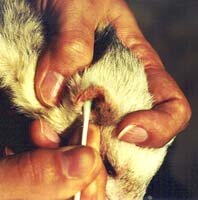-
- Note:
- These articles and images are copyrighted and may not be reprinted, re-used, reposted, copied, or otherwise distributed without permission from the author.
Disclaimer:
You should not rely on the veterinary advice or information provided on this site for diagnosis or treatment of any specific situation. Always consult your own veterinarian for specific advice concerning the medical condition or treatment of your own pet or animal.
 - Miticide and ear cleaning equipment
 - Slinky's ears are cleaned regularly to keep earmites away
|
- ARE EARMITES EATING YOUR FERRET’S EARS?
© Erika Matulich
- Earmites in ferrets are often known as the "ferret social disease." Here’s some tips on diagnosing and treating this common ear problem.
-
- What’s That Smell?
- When I brought my first ferret home, I noticed Critter had an unusual odor about her face. I gave her repeated baths in vain (not knowing at the time that frequent bathing is not good for your ferret). I then noticed that the smell came from black, stinky ear wax. Daily ear cleanings did not help, so I took Critter to the vet. Diagnosis: ear mites!
-
- Where Do Earmites Come From?
- Earmite infestations are frequently acquired right after birth or when the ferret has close contact with other ferrets, dogs, or cats. The mites are too small to be easily seen with the naked eye, but the dark, crumbly or black waxy debris they create in the ears of their host is often abundant and smelly. Almost every baby ferret I have seen at a petstore has had earmites! It is safe to assume that any new ferret you bring home may have earmites.
-
- What Are the Symptoms of Earmites?
- Besides an overproduction of black, odorous ear wax, the presence of the mites can be irritating to the unfortunate ferret who may rub his head, scratch his ears or repeatedly shake his head. (These irritation symptoms are usually much more dramatic in dogs and cats!) Occasionally the mites may spread to other parts of the head and body; under extreme infestations, the mites may burst the eardrum and cause much deeper, middle or inner-ear infections. Diagnosis can be verified by your veterinarian collecting some ear debris and examining it under a microscope. Either the mites or their eggs will usually be found in abundance. You might also be able to see the mites marching around in the ear through an ear scope.
-
- Eradicating Evil Earmites
- The ferret earmite treatment regiment will take two to three weeks. During this time, you can either have your veterinarian treat the earmites on a weekly basis or you can do at-home treatments on a daily basis.
-
- A veterinarian can apply drops of ivermectin in the ears once a week for 2-3 weeks, if you and your ferret would not enjoy a daily treatment at home. Ivermectin should not be used on pregnant ferrets. One of my rescue ferrets, Compton, was picked up with such a severe case of earmites that the veterinarian used ivermectin injections instead of drops. These weekly shots cleared the earmites from Compton’s face, skin, outer ear, and inner ear.
-
- The at-home method of treating earmites consists of applying miticide (labeled as safe for kittens) on a daily basis and cleaning out the ear debris. If mites have spread outside the ear, flea powder may be necessary on the skin. The miticide method requires diligence to get the daily drops rubbed into a struggling ferret’s ears and may take several weeks to completely cure the problem. My ferrets HATE this treatment, and I usually need lots of ferret treats and help from another person. Once the earmites are gone, keep them away with regular ear cleanings.
-
- Be Careful Choosing Your Cure
- In general, miticides that are labeled as safe for kittens or young rabbits are usually suitable for ferrets. There are some labeled for puppies that are too strong, and don’t use any that are safe for just dogs and cats. In particular, avoid the ingredients betamethasone BP, neomycin BP and monosulifiram. Ear mite drops that are too strong can cause damage to the outer ears of ferrets which means surgical removal of part of the ear! The best active ingredient for ferrets in an earmite treatment is pyrethrin. It is not known whether the active ingredient rotenone is harmful to ferrets or not. My favorite earmite remedies are Nolvamite, Mita-Clear, and Eradimite.
-
- It’s a Family Affair
- Because ear mites are so contagious among ferrets, cats, and dogs, all household pets must be treated at the same time. Treat even those pets who do not have the obvious mite infestations, because the treated pet may be reinfected immediately after the end of treatment by those animals who were not treated. But don’t worry, the humans in the family won’t need any treatment!
|